new posts in all blogs
Viewing: Blog Posts Tagged with: cuba, Most Recent at Top [Help]
Results 26 - 37 of 37
How to use this Page
You are viewing the most recent posts tagged with the words: cuba in the JacketFlap blog reader. What is a tag? Think of a tag as a keyword or category label. Tags can both help you find posts on JacketFlap.com as well as provide an easy way for you to "remember" and classify posts for later recall. Try adding a tag yourself by clicking "Add a tag" below a post's header. Scroll down through the list of Recent Posts in the left column and click on a post title that sounds interesting. You can view all posts from a specific blog by clicking the Blog name in the right column, or you can click a 'More Posts from this Blog' link in any individual post.

By: Jessamyn West,
on 6/23/2008
Blog:
librarian.net
(
Login to Add to MyJacketFlap)
JacketFlap tags:
library,
iowa,
cuba,
blogz,
twitter,
libraryjuice,
poverty,
flood,
cedarapids,
cubanlibraries,
ryandeschamps,
Add a tag
As may be obvious, I’m a little behind on my feeds. The good news is that there’s a lot of good stuff there. The bad news is that you may have seen some of it. Here are a few quickie notes that I think merit some attention. My apologies if you’ve all seen them before. My personal goal is to be all caught up on feeds by the time I leave for ALA — Thursday morning — and don’t get behind again. I think it’s doable.
 How do you follow up the multiple award winning book, The Poet Slave of Cuba: A Biography of Juan Francisco Manzano? Margarita Engle continues to provide a window into the rich and violent history of Cuba with this new collection of poems from multiple points of view on the several wars for independence from 1850-1900, The Surrender Tree; Poems of Cuba’s Struggle for Freedom.
How do you follow up the multiple award winning book, The Poet Slave of Cuba: A Biography of Juan Francisco Manzano? Margarita Engle continues to provide a window into the rich and violent history of Cuba with this new collection of poems from multiple points of view on the several wars for independence from 1850-1900, The Surrender Tree; Poems of Cuba’s Struggle for Freedom.
The Surrender Tree also combines real life characters (the legendary healer Rosa la Bayamesa) with imagined individuals to construct a compelling narrative of escape and hiding, heroism and healing. A former slave, Rosa (and her husband) devotes her life to caring for people, both runaways and persecuting soldiers, using only native plants and herbal remedies with skill, compassion and faith—all while living in hiding and on the run.
Set in the lush landscape of Cuba’s jungles and caves, the story-poem moves forward moment to moment across three wars fought by natives and fueled by outsiders. The plight of the Cubans themselves is a dramatic counterpoint for any war waged in the name of power and possession. But the decency and dignity of our heroine, her husband, Jos, her young protégé, Silvia, and many who prevail despite overwhelming odds makes for an inspiring and humbling saga.
I marked several powerful poems to share out loud, but chose this one as my favorite here for its understated simplicity and layers of meaning:
Rosa
This is how you heal a wound:
Clean the flesh.
Sew the skin.
Pray for the soul.
Wait.
Engle, Margarita. 2008. The Surrender Tree; Poems of Cuba’s Struggle for Freedom. New York: Henry Holt, p. 73.
What a powerful poetic voice, inspiring Latina writer, and distinctive ambassador for Cuba’s history.
For more Poetry Friday gems, go to my former student's blog, Becky's Book Reviews. Go, Becky!
Picture credit: www.schoollibraryjournal.com
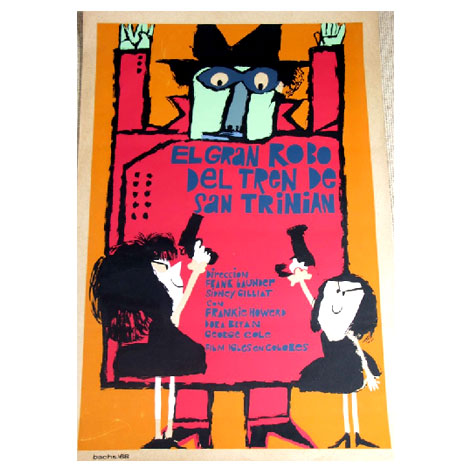
El Gran Robo Del Tren De San Trinian - c1968
I recently received an email for this great new blog that focuses on Cuban posters. The site is a wonderful resource for posters produced by ICAIC, OSPAAAL, COR, Casa de las Americas and other cultural, political and social agencies in Cuba.
1960s,
blogs,
Cuba,
graphic design,
illustration,
postersShare This
©2007 -Visit us at Grain Edit.com for more goodies. 

By:
Elaine Anderson,
on 2/29/2008
Blog:
Fahrenheit 451: Banned Books
(
Login to Add to MyJacketFlap)
JacketFlap tags:
cuba,
freedom of speech,
librarians,
freadom,
ernest hemmingway,
gabriel garcia marquez,
ernest hemmingway,
freadom,
gabriel garcia marquez,
Add a tag
There isn't much to report on concerning Cuba's Freedom to Read from my personal experience there. I did learn that there is a great emphasis on education and literacy. Whether or not that translates into freedom to read or free thinking is best left with Freadom, an organization which stands up for Cuban librarians and others who have been jailed for supporting the freedom to read.
A quick visit to a public library in Havana revealed books in worn condition.
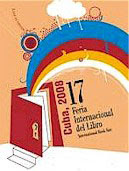 The Cuban International Book Fair is a celebration of literacy and many families take the time to visit. It is definitely a "must do," if in Cuba in February.
The Cuban International Book Fair is a celebration of literacy and many families take the time to visit. It is definitely a "must do," if in Cuba in February.
Surprising to me was the literacy campaign, which Castro initiated in 1961. It is reported that "eleven months later, 707,212 people had learned to read and had written letters to President Castro to prove it and say thank you." For more information visit a Photo report: Literacy and computer literacy in Cuba.
As a postscript, may I recommend a couple of authors for the "Banned Book Challenge?" Although Gabriel Garcia Marquez was born in Columbia, he began to align himself with the Cuban revolution which reflected his Utopian politics. He spent time in Cuba and eventually became a person friend of Fidel Castro.
Ernest Hemmingway lived out his last days in Cuba. Visitors to Cuba will find a museum dedicated to his life and work and numerous drinking establishments that claim that Hemmingway drank there. Take a tour of Old Havana on Hemmingway's trail. He has been honoured by the people of Cuba who regard him as one of their own. Ironically, according to Study World's entry on Ernest Hemmingway, his father was a strict man who censored what his children could read.
Spending much time checking out the Internet, sifting through all the chaff could make you senile. So, when we started La Bloga we intended it not only to focus on Chicano literary themes, but also to strive for higher standards than a typical blog, by our "passionate" (see Laínez's post from yesterday) understanding of cultural distinctions. As example of the type of site we didn't want, one recently came to our attention and warrants comment, given its topic.
On 12/15/06 Manuel Ramos's post introduced Rudolfo Anaya's The First Tortilla: A Bilingual Story. The blurb quoted publisher UNM Press: "She [Jade] has made the first tortilla." It also mentions a Mountain Spirit and talking hummingbirds. Sounds like a fantasy, folktale or leyenda, right?

In our 7/18/07 review of The First Tortilla, Bloguista Gina MarySol Ruiz wrote: "Rudolfo Anaya has written a magical and lovely folktale about the origins of that favorite of us mexicanos/Chicanos, the delicious tortilla." Note her use of "folktale" and "the origins of the tortilla."
When the editors of Guanabee read our review, they remarked: "Finally, a role model for young Mexican girls that doesn’t ask them to sell out so damn hard… but make tortillas instead?" While their first remark may or may not be commendable, it is the "make tortillas instead" that begs literary interpretation.
That anyone, Latino-oriented or otherwise, could misconstrue a folktale about the first tortilla as somehow advocating that contemporary, young Mexican girls should make tortillas instead of aspiring to other (unnamed) activities, indicates either a low level of vocabulary or deliberate misinterpretation.
Using Guanabee logic, we'd expect their editors to review Little Red Hen and the Grains of Wheat and vilify its author(s) for advocating that young females take up bread making instead of other (unnamed) activities. Or perhaps they think the authors of another old story, about Adam and Eve, didn't want 21st century females eating apples.
A folktale about the distant past or a fantasy world, with talking hummingbirds or hens (or serpents), should not be interpreted as providing lessons or role models, solely based on the plot. Guanabee editors seemed to understand part of that. It's the part they didn't that separates Guanabee from La Bloga.
If we read further into the post: "Bless Me, Ultima, the novel that taught us Mexicans/vomiting can be literary motifs", one wonders what they consider to be rational critique. Characterizing Anaya's recognized classic in this fashion seems like a shallow way to artificially create controversy. In their own words, "Guanabee is commentary on media, pop culture and entertainment, spicy coverage for the Latino in you."
Now, I don't know about you, but the Latino in me prefers that spicy coverage not approach the abyss of Fox-TV standards of verity. Guanabee is a commercially supported site, filled with "ads by Google" and other business interests, including Fox (by chance?), so perhaps the "spicy" in Guanabee is simply intended to generate more hits-per-month to support their bottom line. That it generated my hit, indicates outrageous deviations from common sense can make money. This is another aspect where La Bloga separates from other Internet sites in that we deliberately avoid commercial interests.
Comments to the Guanabee post likewise reflect more grasping at straw men and low-level bursts of supposedly smart remarks like, "The highly-anticipated sequel to [The First Tortilla] will have Jade pushing Qdoba burritos in central Los Angeles. . ." That my post may generate more Guanabee hits is only unfortunate in that at times you need to know what a bad tortilla tastes like to better appreciate homemade ones. While we know La Bloga's "cooking" doesn't always reach what we strive for, be assured we won't go commercial on you and forsake the literary for the North American corporate dollar.
* * *
Due to popular demand I decided to pull the second part of this post until I read The Confessional. I will leave the Comments, though.As I said in that part, "I've had to eat my words before." In this case readers let me know they felt I do need to to set the table and gorge on some of my own masa. I'm going for the masa.Rudy Ch. Garcia

I, Carmelita Tropicana: Performance Between Cultures
Hello people, you know me, I know you.
I am Carmelita Tropicana.
I say Loisaida is the place to be. It is multicultural, multinational, multigenerational, mucho multi.
And like myself , you've got to be multilingual.
I am very good with the tongue.
"This book makes you cry in one eye and laugh in the other."
-John
Leguizamo, author of
Freak"Alina
Troyano's one-woman shows, plays, and essays have astonished audiences and readers with their creativity, humor, and crackling political energy. I, Carmelita Tropicana offers the first comprehensive collection of her work, from "
Memorias de la
Revolución" (with Uzi
Parnes) to "Your
Kunst is Your
Waffen" (with
Ela Troyano).
"The writing in this wonderful book is like
café Cubano: rich, strong, satisfying." -Steve
Buscemi"Dwellers of the Lower East Side have long known of the magic they call Carmelita Tropicana. Carmelita and her comrades-in-arms teach us that humor can have a subversive edge and that politicized performance can be hilarious. This book is a triumphantly tacky treasure trove of tropical delights." -
José Esteban
Muñoz, author of
Disidentifications"The inimitable Carmelita Tropicana is one of the queer world's wonders: sexy, outrageous, and insightful, her performances transform rooms full of strangers into communities of lovers, friends, and admirers."-Jill
Dolan, author of
Presence and Desire"Laughter is
Troyano's weapon, and she wields it expertly to send up stereotypes like the Latina spitfire and to push the limits of rigid identities. This long-awaited book will be a boon in any classroom studying performance, as well as in racially and gender-inflected queer and cultural studies." -Yvonne
Yarbro-
Bejarano, editor of
Chicano Art: Resistance and Affirmation, 1965-1985Alina
Troyano, Cuban-born writer and performance artist, is the recipient of a 1999 Obie award for Sustained Excellence of Performance, and named by
el Diario as "
una de las mujeres mas
destacadas de 1998." She has presented her work nationally and internationally in both English and Spanish.
As a writer she has distinguished herself since 1985, when she was selected to participate in
Intars musical Theatre Labs under the direction of Graciela Daniele and George
Ferrencz.
She has received fellowships from the New York Foundation for the Arts for Performance Art, as well as for screenwriting and
playwriting. She has received a
CINTAS Foundation fellowship for her literary work, as well as a 2001 writing fellowship from The Mark Taper Forum, a 2002 writing fellowship from the Cuban Arts Foundation, and in 2003 the Plumed Warrior writing award from
LLEGO, a National Latin Gay Lesbian Bisexual Transgender Organization.
In 2000, Beacon Press published
I, Carmelita Tropicana: Performing Between Cultures, a Lambda Award nominee for theatre. In the opening quote in this article, Alina is speaking as her Latin-bombshell persona, Carmelita.
Troyano has sampled the 'exotic other' archetype of Carmen Miranda, and put a queer, radical aesthetic spin to her. Hardly the palatable fantasy of the easy-conquered, not-too-bright Carmen.
This is a book that made me laugh out loud. It is part “diary”, part monologue, part cultural commentary by one Carmelita Tropicana, a.k.a. Alina
Troyano.
Troyano is a Cuban lesbian performance artist whose work skewers racial, cultural, and sexual stereotypes. Carmelita is my new patron saint.
In the preface there is a reference to
Troyano's use of 'innuendo, bilingual puns, double
entendre, burlesque, parody, political farce, biographical revisionism, and an irreverent appropriation and
collaging of popular culture.' She draws text from popular movies, past stereotypical icons, and popular music. While the style is irreverent, her themes are hardly light. In placing expropriated material in another context, it becomes reinvented, with layers of new meaning and ultimately a critique of the original manifestation itself.
In a piece entitled
Your kunst ist your waffen, Carmelita/Alina pokes fun at performance art and sexual stereotyping. In a monologue to the audience, she explains how a “fairy” godmother told her it was her destiny to sing and dance in the tradition of Carmen Miranda. The vaguely sexual title of the piece conjures up images of lesbian sex. In reality, it translates to ”Your art is your weapon.”
She goes on, in a fictitious diary, to satirize Castro, boat people, Catholicism, traditional ideas of Latina femininity and family life. In her “diary”, Carmelita/Alina reveals that as as prison entertainer, she saw a group of nuns behind bars singing a rancher song entitled:
Prisoneros de Amor/Prisoners of Love. I admired and enjoyed
Troyano’s brashness, her satiric wit, and her willingness to take the starch out of some of our (Latin) sacred icons. There is also an inherent political act in lifting, deconstructing and
revisioning elements of popular culture in this way.
To better illustrate her work and style, I want to close with an excerpt from her performance at New York's New Museum of Contemporary Art.
Recipe for Carmelita's Bad Girls Show at the New Museum of Contemporary Art.
INGREDIENTS
1/3 Pingalito (Carmelita in male drag) recites
"Ode to the Cuban Man" from Milk of Amnesia
1/3 Carmelita delivers Performance Art Manifesto (which varies based on the audience, how Carmelita feels at any given moment, and the venue.)
1/3 The Art Quiz Show
HOW TO MAKE THE ART QUIZ SHOW
Sprinkle clues for the audience to guess the artwork
or artist recreated in live tableaux.
Add pinch of art commentary to taste and blend with 1 generous dollop of modern dancer Jennifer Monson (collaborator) whisked rapidly for Duchamp's Nude Descending a Staircase. Set aside.
IN A SEPARATE PAN MIX
1/2 cup Jennifer as Cupid with piercing arrow and 1/2 cup Carmelita moaning, hanging on museum fire escape.
Simmer to Wagner's Tristan und Isolde and stir until both harden into Bernini's sculpture The Agony of St. Theresa.
For skewering performance art's often ponderous images and general pomposity, and for giving queer aesthetics a decidedly Latina sabor....Que Viva Camelita!
ISBN: 0807066036
Lisa Alvarado

translated by Peter Bush. NY: Akashic Books, 2007.
ISBN-13: 978-1-933354-19-4
Michael Sedano
The tango is a fascinating dance requiring sure-footed twists, turns, and other intricate moves by a pair of dancers. Daniel Chavarria’s novel, Tango for a Torturer, offers the same kind of plot, filled with twists, turns and intricate moves. And, just as dancing the tango is a lot of fun, reading Tango for a Torturer likewise offers a ton of fun.
Set in Cuba at the turn of the century (2000), Chavarria reaches thirty years into the past, to the depraved policies that infected parts of South America in a series of dictatorial regimes whose accused revolutionaries and political opponents disappeared into police custody. In some cases, the children of the disappeared were adopted by their parents’ torturers. Interested readers will find a large list of titles that address the period.
If anyone deserves revenge out of that era, Chavarria posits, it’s victims of these monsters. Meet Aldo Bianchi, the victim of his own unforgettable monster, Orlando Ortega Ortiz, “Triple O.” Aldo and his wife were imprisoned and tortured by OOO. The woman was gang raped and suffered agonizing sexual torture before being killed by a cattle prod. Aldo, a wealthy man, was forced to watch. Then, Ortega humiliates and sodomizes Aldo, finally extorting a hefty chunk of money from Aldo and releases the victim.
As the regimes came crashing down, Triple O escaped behind bodyguards and his wealth. But Aldo finds “Captain Horror”, another of Ortega’s handles, and, after two failed sniper attacks, loses track of the torturer. Until one day in Havana, Aldo hears two prostitutes laughing when one of the women says a word that had been OOO’s favorite expletive. From this chance meeting, Aldo engages the whore Bini to help him track down Triple O, who calls himself Alberto Rios. Rios, a rich Argentinian businessman living in sybaritic luxury in Havana, is one of Bini’s regular customers.
Readers of Chavarria’s highly recommended first novel, Adios Muchachos, will enjoy a remarkably comedic crime caper. In Tango for a Torturer, there’s little comedy. Getting even with a torturer is deadly serious business. Every step toward the success of the plan faces tension-building obstacles. Will Rios/Ortega escape once again owing to his money, his political connections, his sheer brutality? Will Aldo’s and Bini’s luck run out? The tension builds to almost intolerable heights.
“Don’t judge a book by its cover” is a useful reminder for book browsers. The blurb on the back cover describes Aldo and Teresita as Argentine revolutionaries. How odd, and misleading. Aldo’s bitter irony is that he and Teresa were not revolutionaries, the “legitimate” targets of the regime. Ortega insults Teresa on the street, hotheaded Aldo responds in outrage and kicks Triple O in the balls. A trained karate expert—Ortega both attended and taught at the School of the Americas and similar US military/CIA training courses—Ortega recovers quickly and thrashes Aldo before taking him and Teresa into custody. The couple’s abduction, murder, and torture occurs totally out of random coincidence, and the couple simply served for O to have a little fun.
Tango for a Torturer makes an excellent companion to other torture-themed works. I recommend reading Chavarria and two others, Ariel Dorfman’s Death and the Maiden and Lawrence Thornton’s Imagining Argentina. In Thornton’s book, a husband goes in search of his disappeared wife, in the process revealing horrors such as sexual torture and child-stealing. Dorfman’s brings a torture victim face to face with her torturer, a guest in her own home.
Peter Bush provides a highly readable translation that makes the novel’s 340 pages move swiftly. I do wonder what the Spanish phrases must be for the frequent iterations of “fuck”. There’s lots of (relatively) innocent sex and only a little gore. As a result, the squeamish reader won’t find much to avoid, yet the pruriently motivated reader won’t find a enough to slake that thirst. Everyone else will find this, and several other Akashic Books titles, exciting finds that they’ll be anxious to share with friends.
In fact, Manuel Ramos already has. See Manuel's review of Tango here.
Blogmeister's note: Rudy Garcia will rejoin La Bloga's regular contributors as our Sunday guy. Soon. Look for Rudy's byline. In the meantime, remember La Bloga always welcomes guest columnists. If you'd like to be a La Bloga contributor, click here and let me know. And, of course, La Bloga's Blogueras and Blogueros enjoy reading your commentary and feedback on what you see here. We encourage your comments on this, and all posts. See you next week! mvs
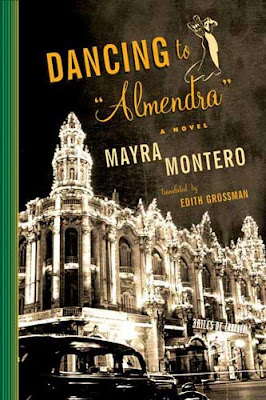
Dancing to Almendra
Author: Mayra Montero
Translated from the Spanish by Edith Grossman
Publisher: Farrar, Straus & Giroux
ISBN-10: 0374102775
ISBN-13: 978-0374102777
Dancing to Almendra takes place in Mafia-dominated 1950’s Cuba before Castro takes over. It begins with a bizarre killing of a hippopotamus at the local zoo and young journalist Joaquín Porrata is sent to write up the story. Joaquín usually covers fluff pieces but desperately wants to be a real reporter covering more important things. He stumbles onto something at the zoo where he learns that the killing of the hippo was a warning to mob boss Umberto "Albert" Anastasia, who really was murdered in 1957. Joaquín starts investigating and begins to uncover an incredible story. He is threatened, beaten, warned and scared the hell out of, but he keeps on investigating and uncovering more and more.
As the investigation deepens, Joaquín’s life starts to spin out of control. He travels to New York, meets both Meyer Lansky and George Raft and finds out much more than any person should know about the Mafia.
The characters are all intensely interesting and detailed. Joaquín’s father and brother Santos, his lesbian sister and his tragic martyr of a mother are all fascinating. Yolanda, the ex circus performer, one-armed mulatta lover of Joaquín as well as Santos Trafficante and mother of a trapeze artist is simply too wild and wonderful not to love.
The story is told in Joaquín’s hard-bitten, matter of fact voice with alternating chapters told in a mystical way by Joaquín’s lover Yolanda. The Cuba of the 50’s comes to life with Mayra Montero’s incredible writing. She paints a decadent picture of nightclubs, music and gaudy casinos where an underlying threat of revolution is bubbling to the surface.
Dancing to Almendra is a gorgeous book about a crazy time and Montero manages to paint both the garish, brightly lit surface as well as the darkness underneath it all with a deft hand.

Dancing to Almendra
Author: Mayra Montero
Translated from the Spanish by Edith Grossman
Publisher: Farrar, Straus & Giroux
ISBN-10: 0374102775
ISBN-13: 978-0374102777
Dancing to Almendra takes place in Mafia-dominated 1950’s Cuba before Castro takes over. It begins with a bizarre killing of a hippopotamus at the local zoo and young journalist Joaquín Porrata is sent to write up the story. Joaquín usually covers fluff pieces but desperately wants to be a real reporter covering more important things. He stumbles onto something at the zoo where he learns that the killing of the hippo was a warning to mob boss Umberto "Albert" Anastasia, who really was murdered in 1957. Joaquín starts investigating and begins to uncover an incredible story. He is threatened, beaten, warned and scared the hell out of, but he keeps on investigating and uncovering more and more.
As the investigation deepens, Joaquín’s life starts to spin out of control. He travels to New York, meets both Meyer Lansky and George Raft and finds out much more than any person should know about the Mafia.
The characters are all intensely interesting and detailed. Joaquín’s father and brother Santos, his lesbian sister and his tragic martyr of a mother are all fascinating. Yolanda, the ex circus performer, one-armed mulatta lover of Joaquín as well as Santos Trafficante and mother of a trapeze artist is simply too wild and wonderful not to love.
The story is told in Joaquín’s hard-bitten, matter of fact voice with alternating chapters told in a mystical way by Joaquín’s lover Yolanda. The Cuba of the 50’s comes to life with Mayra Montero’s incredible writing. She paints a decadent picture of nightclubs, music and gaudy casinos where an underlying threat of revolution is bubbling to the surface.
Dancing to Almendra is a gorgeous book about a crazy time and Montero manages to paint both the garish, brightly lit surface as well as the darkness underneath it all with a deft hand.
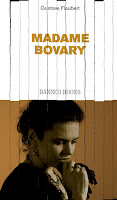
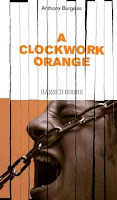

Ted Mahsun, of "Manuscripts Don't Burn", Malaysia posts an entry about the UK Independent releasing a series of books that have been banned or challenged. They have great cover art and are also identified on the cover as being banned. They offered special editions to their print readers each week. UK readers can check this week's banned book here.
Banned Books is an exclusive collection of 25 cutting-edge titles, censored classics and literary landmarks by authors including Ernest Hemingway, Vladimir Nabokov, Franz Kafka, Andre Gide, Maya Angelou, William Burroughs, Kurt Vonnegut, Henry Miller and Ray Bradbury, specially published and packaged for Independent readers.
Join the Pelham Public Library in taking the
"Banned Book Challenge." Our Malaysian and Cuban friends would ask you to consider reading a book that is
banned in Malaysia or being
burned in Cuba.
In a press release dated January 23, 2007, authors and librarians are urging people to "Read a Burned Book."
Some of the most famous Cuban writers have joined with the head of Cuba’s major independent library group in endorsing a new “Read A Burned Book” campaign, aimed at getting high school and college students to read the books which Fidel Castro has ordered burned. An organization named Freadom has information and links on how you can support this campaign.
“Castro can destroy everything, except for books,” said legendary Cuban revolutionary and author, Carlos Franqui. “He may censor, ban or even burn them, but the ideas contained in books can never be destroyed.”

Those of you who didn't come up with resolutions for the new year--or your life--can plagiarize anything below that fits.
1. Get drunk with your mom in her adobe house.
If you live long enough, you'll get discomforting reminders from afflicted family and friends that we're all mortal. I still have one parent and hope to kill a bottle of Presidente brandy with her in an adobe made under her specs and supervision. She attended an adobe construction school in Arizona and remembers it well. Your parent likely has a different dream; find what it is and jointly kill your preferred bottle, once it's accomplished. I did this once--a memory worth repeating.
2. Become a master teacher.
Yours might not be about teaching, so substitute your own mastery. It's not about which craft; once upon a time, human culture was a life-journey from novice to master craftsman, for every trade. Today, instead, we go from job to job or are often forced to change careers. But at least once, disregard the mierda your bosses or company shovel onto your back and decide you'll learn more about your employment than your boss could ever know. Then go past that until you stand above all the mediocrity that passes for "competent."
3. See and hear a jaguar in the Petén jungle; settle for a mt. lion.
They're as equally endangered and unique as whales, wolves or polar bears, so take your pick. But do it before our presence on the planet leaves a gap in your time here. I'm not greater than a jaguar--my personal favorite--especially when it comes to who fits better into the environment. That's why I'd like to meet Jaguar, on his turf, no matter I hide behind the leaves. If the encounter turns deadly, at least I'll have checked off this item and perhaps served a great meal.
4. Draw the dinosaur glyphs in an Anasazi canyon.
Yours might be to dance a mambo at Stonehenge or sing Lucy in the Sky, nude, on a barren beach, right before a hurricane, but do it while your legs and voice still work--however you can reconnect with antiquity amid what remains of the simpler, unspoiled world. Mine is getting tribal permission to enter a side canyon closed to non-natives. Drawing the pictoglyphs that resemble dinosaurs presumed extinct before the arrival of humans, would be this artist's dream, and fun; something to leave behind to worry myopic Euro-American scientists.
5. Spend 2 weeks in Cuba.
Cuba is not about Castro's faults or communism's failures; it's about a people who successfully defeated the torturous dictator Bautista and withstood his CIA-U.S. military bullies longer than many of us have been alive. I want to spend time (legally, if Homeland needs to know) with people who live free of student loans, variable-rate mortgages, endless wars and onerous medical insurance. I want to traverse the U.S. embargo (legally, Homeland) and discover life in a simpler society, less oppressed by capitalist materialism. I want to speak Spanish in a country where its literacy is nurtured and revered. Although other places may fit your needs better, do the same before they get invaded. Whatever needs to be changed in any country will be decided by people who stayed and bore the burden of citizenship. Exchanging experiences with Cubanos is a time-sensitive, historically unique opportunity. For one reason or another, things may change soon, not necessarily for the better.
6. Write one book, self-published if necessary.
You'd be in good company: Elements of Style and Bartlett's Quotations were originally self-published; Tarzan and the translation of The Rubaiyat of Omar Khayyam, as well. Shelly, Carl Sandburg, Thomas Paine, Upton Sinclair, Mark Twain and Walt Whitman all resorted to it. So why not? Face it: if you're about my age, you were captivated by Michael J. Fox's changing history in Back to the Future so his dad's SciFi novel got published. But you and I don't have a DeLorean time machine. Fact is, there's too many writers and not enough readers in the English language. If you don't write, splurge on framing an unsold painting or a collage of your own original dichos.
Your self-promotion will stop friends and relatives asking when your work will be exhibited or for sale. Plus, you can put it next to Leaves of Grass and pull it down sometimes to feel its weighty significance. Of course, this suggestion comes from an undiscovered talent, so if you're more talented, or luckier, keep on.
7. 50-yd.-line seats at a Dallas Cowboys game.
Okay, this one's a little self-indulgent, but what would a 10 List be without some of that? Replace this one with your own indulgency, but mine is to be close enough to the DC Cheerleaders to count their freckles, or whatever. Berate me, if you will; I'm probably more flawed than you.
8. Finish the house.
If you're lucky enough (or unlucky enough), you got a house you gotta get done with. That half-finished basement or those unfinished windows will hound you 'til your done, even if you spouse doesn't. At least your widow(er) will then have a nice place to host your wake and not squander the life insurance on less qualified contractors.
9. Play with adopted grandchildren.
Though some of you only want your own grandchildren, I'm not a believer in the arcane "my bloodline must carry on" BS. There's not only too many of us on the planet, there's too many orphaned or homeless little ones out there, many because of U.S. actions within or against their countries. I don't need a grandchild that resembles me or carries a genetic propensity for alcoholism and weight-gain. Why wish labor pains and stretch marks on a daughter or daughter-in-law? Kids are kids, and if we're around them long enough, our genetic make-up preconditions us to love and care for them as if they were our own, no matter.
10. Go on a vision quest.
Since my indigenous blood is as diluted as rosewater and my self-education lacks spine, I never experienced this. My rites of passage amounted to communion and confirmation, both of which focused on my memorizing God's plans and judgements about me, rather than finding out about myself. Whatever your ethnic roots, consider reclaiming a piece of ancient heritage. Modern society's clobbered our psyches to where we've lost connections not only to the planet, its fauna and foliage, but even with our true selves. Spending a week, alone, away from civilization, sans phone or IPod, unable to stuff my gut or fret about societal responsibilities--all that would force me to be with my Self. It would prove more difficult than the other 9, no doubt, but I should discover what's really under there. We could all maybe use some of that. Before we stop.
Rudy Ch. Garcia
_______________
We need 1 new Bloguista contributor!
RudyG must take another spring sabbatical from La Bloga, since he enrolled in two courses to complete his teaching accreditation. Whether he survives the ordeal or not, La Bloga is searching for a new contributor who could more or less regularly post on Thursdays. If you are such a person, or want to nominate someone, please contact any Bloguista. At the least, Thursday will be available for Guest Posts.














Wow that is a powerful poem. I am going to look for this book. Thanks for the review.
It's definitely worth seeking out. Thanks for stopping by!
I loved Poet Slave and now can't wait to read this one. Thanks!
I think you'll love it. I enjoyed POET SLAVE too and found this one even more engaging, if that's possible!